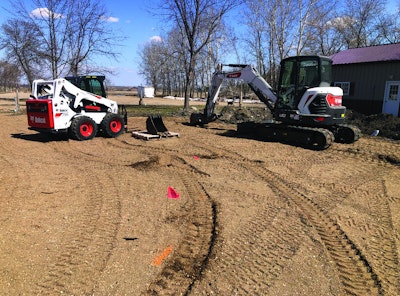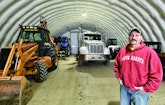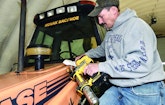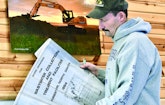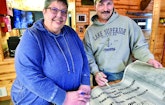
Working in rural North Dakota, Terry Novak has to take on a variety of excavation work, including this culvert installation for an area township. On this job, the crew is using two CASE machines, a 590 Super L backhoe and a 210B trackhoe. (Courtesy of Novak Backhoe)
Interested in Business?
Get Business articles, news and videos right in your inbox! Sign up now.
Business + Get AlertsOne thing North Dakota installer Terry Novak hates about his job is delivering bad news to low-income rural property owners about their failing septic systems.
Often, repair or replacement is financially out of reach for the owners, especially those who are elderly and on fixed incomes. “These are nice people who will invite you in for chicken dinner while you’re working,” says Novak, owner of Novak Backhoe in Lankin, in the state’s northeast corner. “You feel terrible. We need to find some way to get funding for these people.”
He often uses the term “common sense” in advocating for ways to help people correct septic system problems. Such advocacy is part of the agenda for the North Dakota Onsite Wastewater Recycling Association, of which he is a founding member.
“We all want to save our water systems for our kids and grandkids,” says Novak. “We have aquifers out here and we don’t want to damage them. But we have to be realistic for these people. We’re trying to work with the state and do things the way we should, but there has to be some common sense. It can’t always be by the book.”
Novak works in six rural counties, installs about 10 new complete systems a year, and performs numerous repairs that range from minor fixes to replacing septic tanks or drainfields. He pumps tanks for some 200 individual customers and for about 90 homes on a cluster system in the community of Forest River. He also keeps busy with general excavation.
FARMING BACKGROUND
Novak was born and raised near Lankin (population about 100) on a livestock farm. At age 18, he entered a partnership with his father, Ron, and a brother, Curt. In 1995 they bought a rubber-tire backhoe for digging rocks out of their fields.
Then they started doing excavation for townships, upgraded to front-wheel-drive backhoes and added a dump truck. That led to septic system jobs. “As times change and demand increased for all areas of excavation, we added a tracked backhoe,” Novak says. “Then the installation business grew, and we added a mini-excavator and a skid-steer.”
The business kept evolving, and 15 years ago, the brothers bought a grain elevator. That turned into a specialty feed business and later cleaning of certified seed for area farmers during winter.
A disabling illness suffered by his brother changed the family and business dynamics. Novak now operates the business with his wife Yolanda, who does the books and handles permits, licensing and other administrative work.
Older daughter Breanna is a supervisor in radiology at a Grand Forks hospital; younger daughter Brogan is a loan analyst in Grand Forks. Older son Blaine is an instructor in genetics and nutrition at North Dakota State University. Younger son Bryce farms the family land, is in a farming partnership with a brother-in-law and helps in the onsite business.
The pumping business started as Novak began installing more drainfields and first needed to clean the septic tanks. “In this remote area, there were only a handful of septic tank cleaners,” Novak says. “We bought a septic truck so we could pump tanks and not have to schedule around someone else.” The truck is a 2012 Peterbilt with a 3,400-gallon stainless steel tank fabricated by Presvac Systems and carries a Presvac 740 vacuum pump.
PREFERS PLASTIC
Go-to machinery includes a 2012 CASE 210B trackhoe, a 1998 rubber-tire CASE 590 Super L backhoe, a 2022 Bobcat E50 mini-excavator, and a 2018 Bobcat S650 skid-steer.
Septic tank replacements are a substantial part of the business. “In this area, a lot of the concrete septic tanks that were installed in the 1970s are starting to collapse,” Novak says. “This year I’ve run into two of them where the top just collapsed down in.”
He generally replaces failing tanks with 1,000-gallon plastic tanks (Infiltrator Water Technologies) fitted with risers and clean-outs. “They’re easy to work with, and plastic tanks basically last forever. You can’t drive over them, and they have limitations on depth of bury, but these days they’re making them really nice and heavy. They are reinforced, and they are very sturdy tanks.”
The preference for plastic extends to drainfield media in the form of chambers (also Infiltrator).
“We just do conventional drainfields with the occasional lift station where the septic tank is too deep,” says Novak. “Chambers can handle the big flushes of water. You can drain your bathtub, run the dishwasher, do a load of laundry, take a shower. We’ve been installing them for 15 years and never had one come back that has frozen or has gone bad. They’re neat and clean.”
There’s also less disturbance of properties than with the hauling of crushed rock for drainfield: “People want a new system, but they don’t want the yard disturbed. We pride ourselves on being neat. When we finish a project, it’s hand-raked and looks nice.”
MONEY MATTERS
Novak’s challenges have less to do with soil and site conditions than with property owners’ finances. “The demographics in this area are older people,” he says. “There are young families moving in, but they will probably build a new house and pay for a new system as part of a mortgage.
“Elderly people may plan on moving off of the farm in five years, and paying $18,000 for a new septic system is hard for them to swallow, financially and mentally. Realistically, in a few years someone might buy the farmstead, tear the house down and farm the land. Then you have an expensive drainfield that goes unused. Or the owners are on a fixed income and simply don’t have the money to put in a new system.”
When pumping tanks, he has seen “some nightmares.”
“There is sewage surfacing. They’re using a buried steel fuel tank as a septic tank. It’s rusted, it’s shot and they’re leaking water,” Novak says. “On a couple of them I’ve seen, the tank is clearly leaching out, and they have their well close by.”
In less blatant cases, shortcut fixes may be technically possible, but legally out of the question: “For grandma who’s 85 and lives by herself, I’d like to do a Band-Aid for a few hundred dollars to get her by. But under state regulations, I can’t. I have to put in a new system.”
Some limited low- and no-interest loan programs are available, but they still leave the owner with a substantial amount to finance. There have been discussions about using some revenue from the state’s Bakken oil fields to help fund septic system replacements. “I’ve talked to a few state senators and representatives,” Novak says. “They say they’re working on something, but it has been five years and nothing has come down.”
Meanwhile, costs for equipment and supplies are accelerating, especially since the COVID-19 pandemic and its related supply-chain issues. A fitting that cost $8 before might now cost $25. “A septic system in 1975 cost probably $2,000 for a drainfield and a tank. In the old days they could just dig a hole and throw some rock in it. That ship has sailed.”
BANDING TOGETHER
One aim of the state association is to work with policymakers toward affordable solutions for troubled systems and for public money to offset the cost of system replacement for people in need. Two years ago at an installation seminar, a group of contractors got together and discussed mimicking in North Dakota much of what the National Onsite Wastewater Recycling Association does on the national level. They held a few initial meetings and tried to recruit at least one member from each corner of the state.
The organization started in 2021 and now has nearly 100 members: “We’re learning as we go. We’re looking at working with extension offices to help educate the public. We plan to create some kind of outdoor seminar where we set up a system above ground and piece it together so that people can see what a new system consists of.”
The association’s members also would like to see more uniformity in code requirements as opposed to different rules in different counties or districts. “We’re trying to get one code so anyone can work anywhere in the state,” Novak says. “We’d still be inspected. We want to protect our groundwater. We just all want to be on the same playing field.
“There are people quitting the industry because of all the different regulations. I have friends in the business, and with all the hoops we have to jump through, they don’t need the headaches. We should all be able to work together. In the end we’re all after the same result.” Now that his children are on their own, Novak has joined the association board as acting secretary, “with the passion of injecting some common sense, being fair and still being aware of environmental concerns.”
Novak Backhoe works mostly with the Grand Forks Health District on permitting. The process starts with making an application at the county level. County personnel forward the application to the state, and permits are usually issued in about two weeks.
Novak meets with the property owner to discuss the location of the drainfield. A state inspector then visits the site to take soil core samples and size the drainfield according to the size of the household. A state official also does an inspection during the installation, or afterward, but before backfilling.
“We take a lot of pictures to document the way we installed it,” Novak says. “We send the pictures to the land owner. We always install inspection pipes at the beginning and end of each chamber run. When I go to pump a tank, I’ll lift the caps on those to see how far the water is progressing in the chambers. That helps with designing in the future because we can see how systems we put in 10 years ago are acting now.”
A GROWING SECTOR
Pumping quickly became an important line of business for Novak Backhoe: “Right now there are only two pumpers licensed in Walsh County where I live. One is about 30 miles away. We’re friends and we give each other business.”
Novak empties his truck in wastewater lagoons in small cities in the area. When winter conditions make those sites inaccessible, he land-applies on a piece of property he owns that is relatively high in elevation and doesn’t accumulate heavy snow. He does this only after notifying state officials and getting permission.
“One of my favorite things to do is cleaning out tanks,” Novak says. “It’s on a regular rotation. And if people have trouble and you go there on a late evening, if you make their bathroom facilities work on the weekend instead of coming on Monday, you’ve made a friend for life.”
